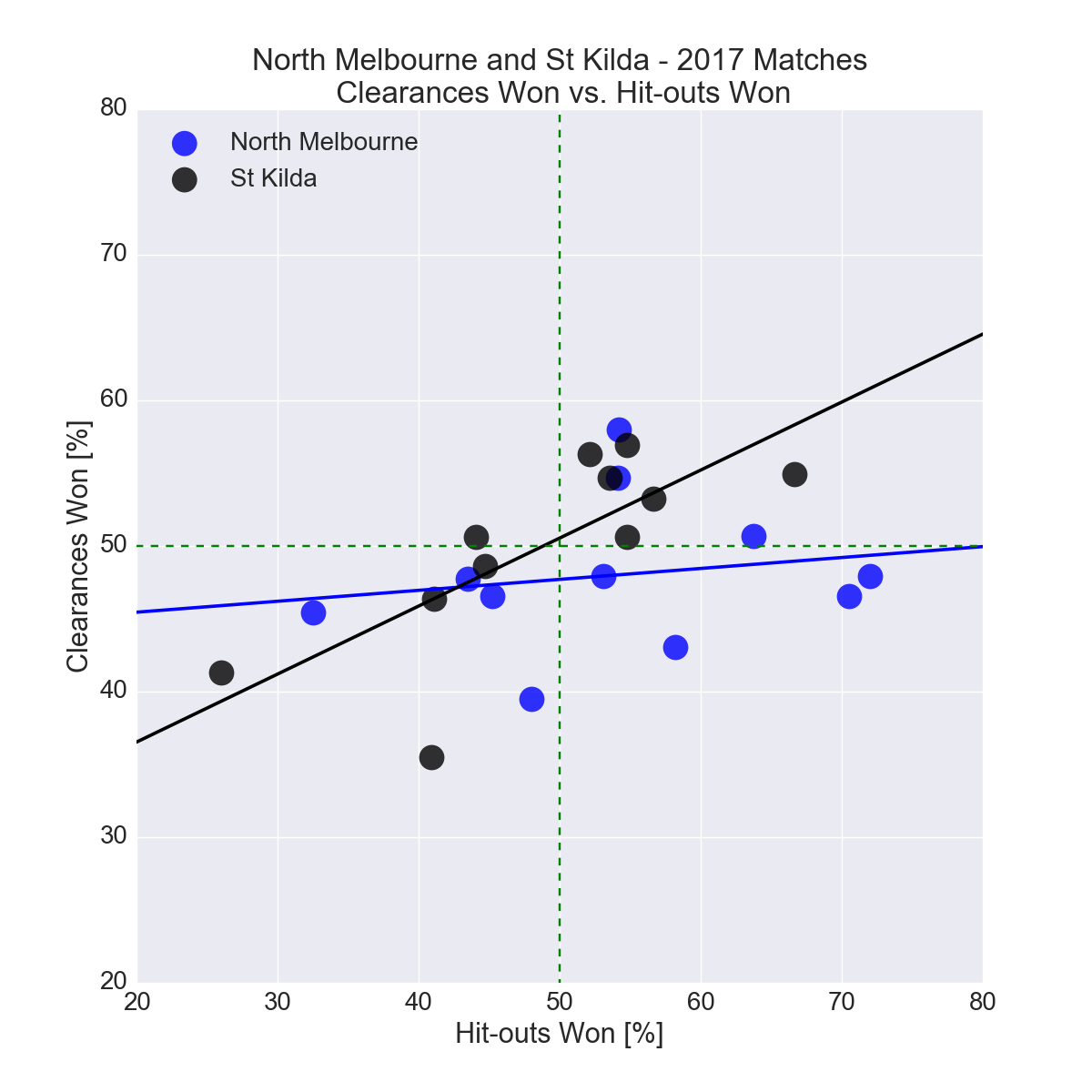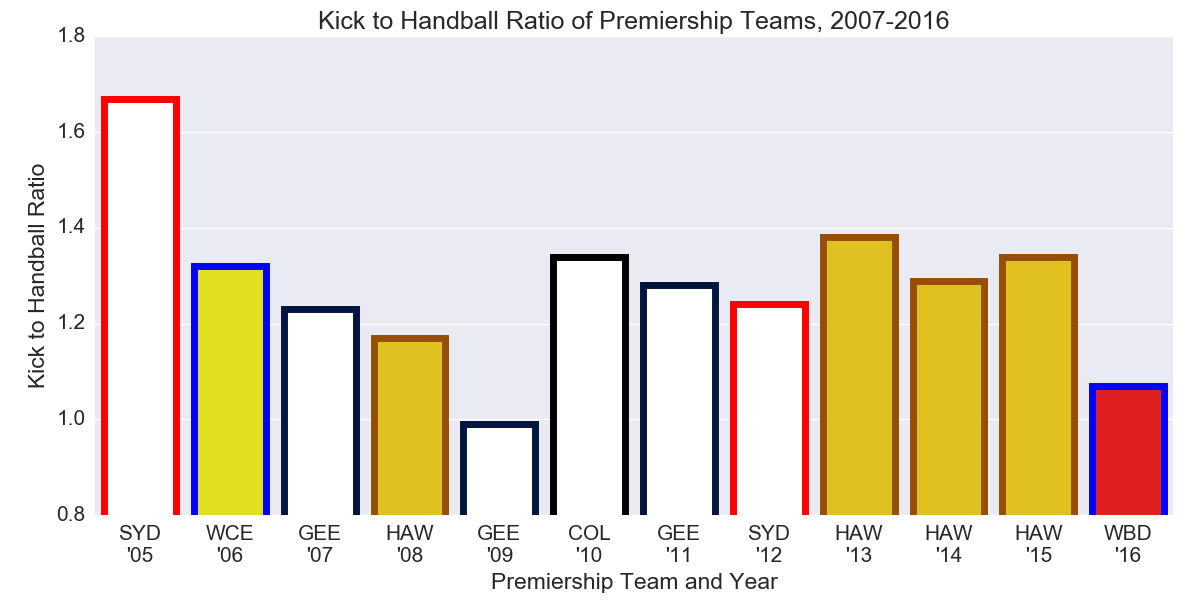AFL Round 12: Melbourne vs. Collingwood
Monday Afternoon, 12th June 2017 at the MCG
----------
The dawn of a new decade promised new horizons for the Australian game – but some things stayed the same. Melbourne and Collingwood continued to sit above the rest of the football world, as titanic, arrogant and seemingly indomitable as Gog and Magog in the Royal Arcade. [1]
Given their struggles over the past half-century, it’s hard to imagine the Demons ever dominating the competition. But that they did in the 1950s, with Collingwood the only team that stopped them from winning 6 consecutive premierships. And the Magpies were not a bad team either, as they did manage to win two premierships themselves in the 1950s (1953 and 1958) and were runners-up to the Demons on 3 occasions (1955-56 and 1960). To emphasise the Demon/Magpie dominance during this period, Table-1 presents the Grand Final results between 1953 and 1960.
Table-1: Grand Final Results 1953-60
Under Norm Smith, the Demons dramatically improved from second last on the ladder in 1953 to beaten finalist in 1954 against the irrepressible Bulldogs. And in 1955 they achieved the first of what would end up being six premierships over the next decade. The longevity of their dominance was aided by the fact that half their 1955 premiership side were 21 or younger, including a 19 year old Ron Barassi Jr.
The dominance of both teams slowed in the 1960s, but there was to be one last hoorah in 1964. The 1964 Grand Final between Melbourne and Collingwood is looked upon as one of the all-time great Grand Finals and in particular one of the most fabled last quarters in Grand Final history. The game was tight and low scoring, but with the favoured Demons holding an 11-point lead at three-quarter-time, the common belief was that the Demons would comfortably account for the Magpies in the last quarter. But with Collingwood kicking the opening two goals of the quarter to get within a couple of points, the stage was set for the dramatic finale and one of the most memorable Grand Final moments [2]:
Tuddenham quickly cleared the ball to the lumbering ruckman Gabelich, who suddenly found no one between himself and the Collingwood goal, about fifty metres away. At a towering 193 cm (6 ft 4 in) and weighing a sizable 109 kg, leg speed and ball handling were not among ‘Gabbo’s’ best attributes, yet he took off towards goal, in what has come to be known as ‘Gabbo’s Run’. Gabelich bounced the ball four agonising times during his gallop, almost losing control each time, until, from the safe confines of the empty goal square, he slammed through the goal to give his ecstatic team a two-point lead.
If that had been the winning goal, it would have been a fitting end with the underdog triumphing against the odds. But unfortunately for the Magpies, it was not to be, as there was more drama to come. Despite several wasted opportunities, the winning goal fell to Melbourne back-pocket Neil Crompton [1]:
He was under instructions by coach Smith to never run forward of the centerline. In the dying minutes of the Grand Final, perhaps impelled by a wave from the coach’s bench he interpreted as an instruction to go downfield, Crompton followed his opponent deep into Melbourne’s forward territory. The ball was driven forward by Brian Dixon, spilled Crompton’s way, and as four black-and-white defenders converged the unlikely hero snapped truly. It was Crompton’s first goal since the 1960 season, but it put Melbourne back in front by four points.
Melbourne held on to win by 4 points, with the final siren sounding with the ball deep in the Collingwood forward line. The last quarter tension was summed up best by Norm Smith: “The last quarter was the most agonizing I have ever experienced in football”. But alas, the premiership triumph was the last hoorah for the Mighty Demons, as Barassi left in the off-season to Captain-Coach Carlton, and Norm Smith was incredibly sacked during the tumultuous 1965 season. Smith was reinstated within a week, but the damage had already been done. It would be 23 years before the Demons played finals again, and the long wait for another premiership continues to this day.
**********
Notes on the 1964 VFL Grand Final Videos: The best video with associated commentary is the first video presented. The video shows the highlights of the last few minutes of the game including the winning goal by Neil Crompton. However, as the video does not include the memorable Ray Gabelich goal, I’ve included the extended highlights as well (with the little more underwhelming overlaid commentary). For quick reference, Gabbo’s Run occurs at the 7 minute mark of the last video. As an aside, I found it interesting that the celebrations by the players after the game were not overtop (compared to modern standards) and the good sportsmanship showed by both winners and losers was commendable. In particular I liked the fact that the two captains stood side by side during the presentation ceremony. And if you watch the last few seconds of the third video you will also see Gabelich, as Collingwood Captain, stand clapping as next to him Ron Barassi receives the Premiership Cup and raises it aloft. Could you imagine if they still did that!
**********
Due to the nature of the Finals Series system at the time [3], Melbourne had the week off prior to each of their Grand Final wins, except for 1957. Although, given the dominance Melbourne had in those years, it is doubtful that it had a significant influence on the Grand Final result. Collingwood even won the 1958 Grand Final after losing comfortably to Melbourne in the second semi-final, forcing them to play 3 weeks in a row in that final series and they still beat the well rested Demons when it mattered most. But there is a tenuous parallel to this weekend’s game, as the Demons are coming off their Round 11 bye to face a Collingwood team not due to have their bye until Round 13. So how much impact does the bye have in a situation such as this?
The bye rounds spread over three weeks has been in place since the introduction of the GWS Giants in 2012. The weeks that they span vary – as early as Rounds 8-10 in 2014 and as late as Rounds 13-15 in 2016. Of the three-week period it is the middle week that is of most interest. In week 1, all teams playing have yet to have had their bye, whilst in week 3, all teams playing would have had their bye. There is a slight exception to the rule this year as Gold Coast and Port Adelaide had an earlier (Round 9) bye due to their Round 8 game in China. Regardless, it is the middle week where there is the potential for a team coming off their bye to face up against a team that has yet to have had their bye. Between 2012 and 2016, this occurred on 22 occasions, for 14 wins to the team coming off their bye, as summarised in Figure-1. The data suggests that there is definitely an advantage to be had in having the week off. For Collingwood, the Monday game this week has given them an 8 day break after their impressive win in Perth. But with the injuries they sustained in that game and the well-rested Demons ready to play, it will be hard to tip against the Demons.
Melbourne to win by 19 points
Figure-1: Match Result between a team coming off their bye against a team yet to have their bye – 2012-16
----------
Additional Notes:
1) For interest, there are 3 other games this week with teams coming off the bye against teams yet to have had their bye (team coming off bye highlighted in BOLD):
· Adelaide vs. St. Kilda
· Brisbane vs. Fremantle
· Carlton vs. GWS
Interestingly the team coming off their bye in each of those games would normally be the heavy underdog. Any chance of some upsets?
2) For anyone unfamiliar with the Gog and Magog reference in the opening quote, they refer to the two mythical Giants that are depicted in statue form in Melbourne’s Royal Arcade just off Bourke Street Mall. For more info, visit the following link:
http://www.weekendnotes.com/gog-and-magog-royal-arcade-melbourne/
----------
[1] Roberts, M., Winkler, M. (2003). “Footy in the 1960s: Six games on a Saturday”, Hardie Grant Books, South Yarra, Australia.
[2] St John, J. (2013). “AFL Premiers: The Fascinating History of Every AFL/VFL Grand Final”, New Holland Publishers, NSW, Australia.
[3] Prior to 1972 the Finals were reserved for the Top 4 teams only, with a 4-week final series with 1 game played each week. Week 1 was the first semi-final (SF1) with 3rd and 4th playing off with the loser eliminated. Week 2 was the second semi-final (SF2) with 1st and 2nd playing off with the winner progressing straight to the Grand Final. Week 3 was the preliminary final, with the winner of SF1 playing the loser of SF2 and the winner progressing to the Grand Final. Week 4 was the Grand Final.




